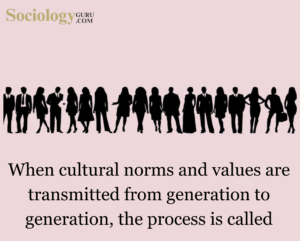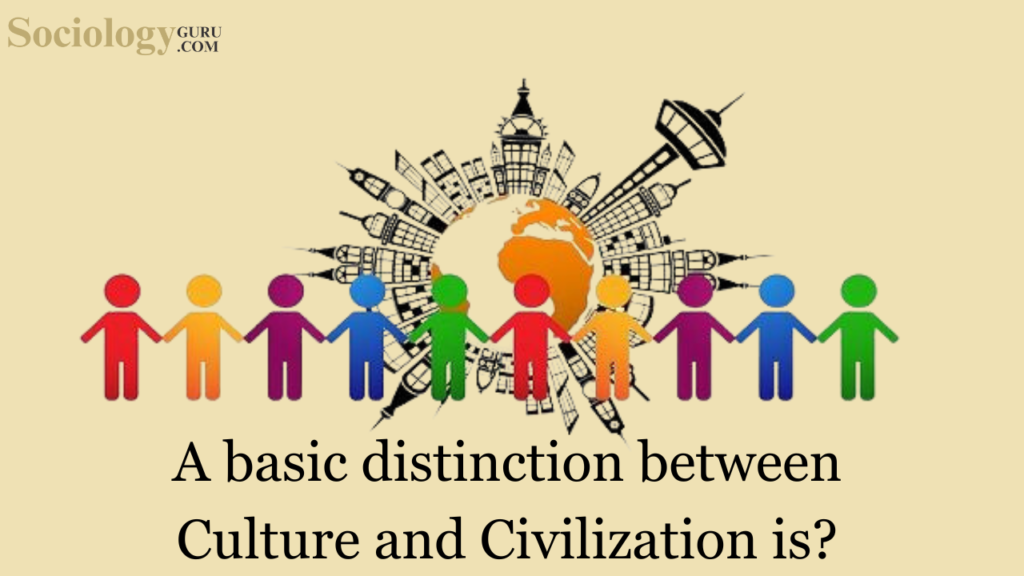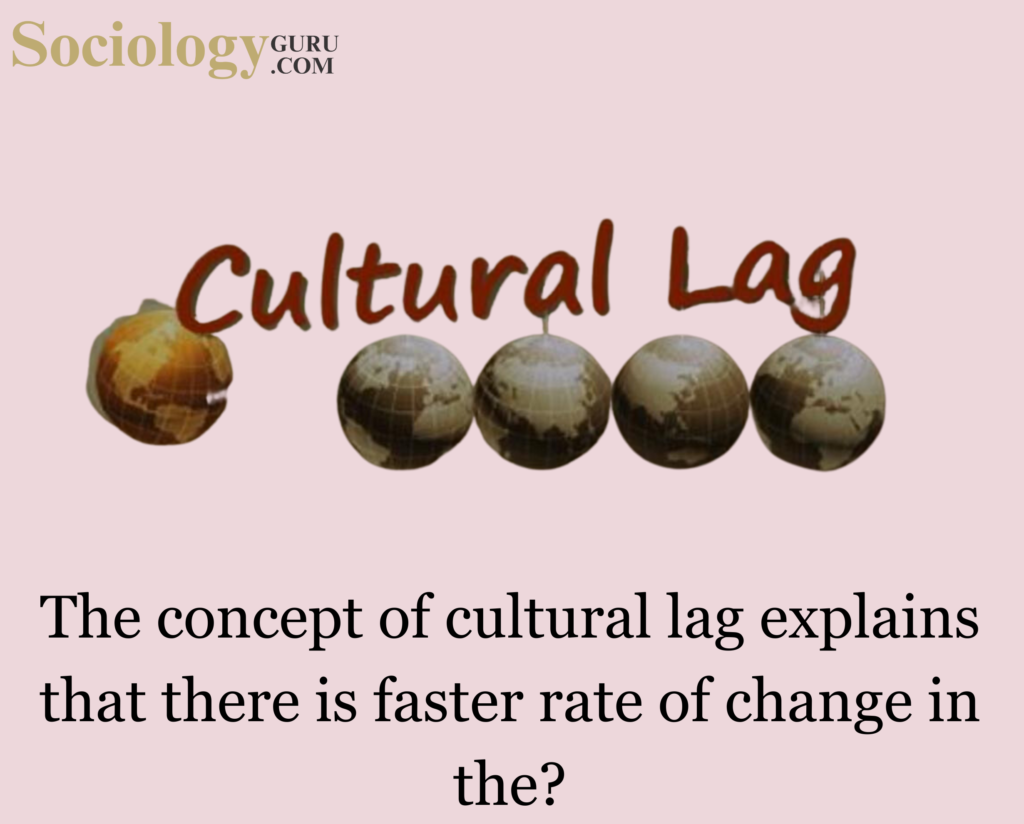Question: When from generation to generation, the process is called?
- Cultural reproduction
- Acculturation
- Cultural diffusion
- Cultural stimulation
Answer: (1)Cultural reproduction, a concept meticulously crafted and presented by the sociologist Pierre Bourdieu, acts as the loom on which the intricate tapestry of society is woven. It operates silently, yet pervasively, weaving threads of norms, values, and practices through the fabric of successive generations, ensuring that the cultural richness of society remains vibrant and intact through time’s passage. At the heart of cultural reproduction lies the essential task of transmitting cultural elements from one generation to the next. This process subtly ingrains individuals with the societal norms and values that have been carefully nurtured over countless generations, establishing a continuity that sustains the society’s cultural identity and collective consciousness. Herein, the societal norms and values are not just passively received by the new generation but actively embodied and lived, ensuring their propagation and preservation through the unfolding epochs. The nuanced process of cultural reproduction extends beyond the mere replication of societal traditions and practices. It dynamically interacts with various societal structures and institutions, such as family, education, and communities, creating a nurturing ecosystem where culture can flourish and permeate through the societal fabric. In this orchestra, each instrument—each societal entity—plays a crucial role in harmonizing the melodies of cultural expressions and shared understandings, fostering an environment where the rhythms of society’s cultural essence can resonate. In the educational domain, cultural reproduction finds a particularly significant platform. Schools and educational institutions act as powerful conduits through which cultural norms and values flow into the minds and lives of individuals. Education, in this context, becomes more than a mere transmitter of academic knowledge. It evolves into a crucial arena where individuals are subtly molded, and societal values are ingrained, ensuring that the essential threads of cultural understanding continue weaving the tapestry of societal consciousness. Cultural reproduction also echoes with the resonances of power and social hierarchies. It subtly plays a role in perpetuating existing societal structures, influencing the distribution of power and privilege within society. The process not only maintains the continuity of cultural practices but also contributes to sustaining and legitimizing the prevailing social orders and hierarchies, reinforcing their presence and influence in the societal landscape. The tapestry of cultural reproduction is also enriched by the colors of diversity and interaction. As societies engage with the flows of globalization and human migration, new cultural threads are introduced into the societal fabric. These new threads, each carrying unique cultural melodies, interact, blend, and contribute to the evolving tapestry of society, enriching its patterns and hues with diverse expressions and influences. Concluding, cultural reproduction emerges as an essential architect of societal continuity and cultural preservation. It operates through subtle mechanisms, weaving the threads of norms, values, and practices into the lives of individuals and the structures of society, ensuring that the tapestry of cultural richness remains vibrant through changing times. The process is multifaceted, dynamically engaging with various societal dimensions such as education, power structures, and cultural diversity, each playing a vital role in nurturing and sustaining the societal cultural heritage. Through cultural reproduction, societies are enabled to traverse through time with their cultural essence gracefully preserved and perpetuated, ensuring the continuity of their unique cultural symphony. |
Take a Quick Sociology Quiz to measure your Performance
Frequently Asked Questions:
1. Question: Define the term “ethnic movement” and provide an example from India.
Answer: An ethnic movement refers to a collective effort by a group sharing common cultural, linguistic, or religious traits, seeking to assert their identity and rights; an example from India is the Khalistan Movement in Punjab.
2. Question: Identify the main objectives behind the Gorkhaland ethnic movement.
Answer: The Gorkhaland ethnic movement primarily seeks to establish a separate state for India’s Nepali-speaking population in the Darjeeling region, advocating for linguistic and cultural recognition and political autonomy.
3. Question: What was the Operation Blue Star, and which ethnic movement was it related to?
Answer: Operation Blue Star was a military action in 1984, aiming to remove Sikh militants hiding in the Golden Temple in Amritsar; it is related to the Khalistan movement, which sought a separate Sikh country.
4. Question: Mention a critical factor that triggered the emergence of ethnic movements in India, as discussed by Dipankar Gupta.
Answer: Dipankar Gupta emphasized that ethnicity is fundamentally a political process, wherein caste and religion, the key components of identity formation, are politicized by leaders for vested interests.
5. Question: What were the primary reasons for the Assam Ethnicity conflicts involving Bodo tribals and Bengali Muslim settlers?
Answer: The Assam Ethnicity conflicts primarily stemmed from issues related to immigration, land rights, and resource allocation, leading to clashes, riots, and evolving relationships among indigenous communities to address challenges.
6. Question: Briefly describe the role of the Dravidian Movement in terms of caste and societal structure.
Answer: The Dravidian Movement, led notably by E.V. Ramasamy, aimed to establish an egalitarian society, focusing on anti-Brahmanism and advocating for equal rights for backward castes, while also introducing reforms like self-respect marriages.
7. Question: Name the prominent ethnic movements in North-East India and specify one common objective.
Answer: Prominent ethnic movements in North-East India include the Nagas’ and Mizos’ struggles; a common objective was to gain autonomy and recognition for their distinct tribal identities and cultural uniqueness.
8. Question: What is the key argument of Gail Omveldt regarding traditional Indian society and multiculturalism?
Answer: Gail Omveldt opposed romanticizing traditional Indian society, arguing that hierarchy has always dominated it and dismissing the notion that multiculturalism is an intrinsic feature of Indian society as a myth.
9. Question: Briefly explain the social hierarchy factor as a contributing element to ethnic movements as suggested by Olzak.
Answer: Olzak suggests that the construction of hierarchies among ethnic communities, which often leads to the suppression of one group by another, is a key factor that can instigate social and ethnic movements.
10. Question: Identify one consequence of the unequal economic development factor within the context of ethnic movements in India.
Answer: One consequence of unequal economic development is the marginalization and underdevelopment of certain groups, leading to feelings of alienation and sometimes initiating ethnic movements as these groups strive for equality and recognition.
To master these intricacies and fare well in the Sociology Syllabus, aspiring sociologists might benefit from guidance by the Best Sociology Teacher and participation in the Best Sociology Coaching. These avenues provide comprehensive assistance, ensuring a solid understanding of sociology’s diverse methodologies and techniques.
META TAGS:
Why Vikash Ranjan’s Classes for Sociology?
Proper guidance and assistance are required to learn the skill of interlinking current happenings with the conventional topics. VIKASH RANJAN SIR at SOCIOLOGY GURU guides students according to the Recent Trends, making him the Best Sociology Teacher for Sociology.
At Sociology Guru, the Best Sociology Coaching platform, we not only provide the best study material and applied classes for Sociology but also conduct regular assignments and class tests to assess candidates’ writing skills and understanding of the subject.
Choose The Best Sociology Teacher for your Preparation?
To master these intricacies and fare well in the Sociology Syllabus, aspiring sociologists might benefit from guidance by the Best Sociology Teacher and participation in the Best Sociology Coaching. These avenues provide comprehensive assistance, ensuring a solid understanding of sociology’s diverse methodologies and techniques. Sociology, Social theory, Best Sociology Teacher, Best Sociology Coaching, Sociology Syllabus.
Best Sociology Teacher, Sociology Syllabus, Sociology, Sociology Coaching, Best Sociology Coaching, Best Sociology Teacher, Sociology Course, Sociology Teacher, Sociology Foundation, Sociology Foundation Course, Sociology CUET, Sociology for IAS, Sociology for UPSC, Sociology for BPSC, Sociology for UGC NET, Sociology for JPSC,
Follow us :
KEYWORD: -Generation to Generation, Generation to Generation, Generation to Generation, Generation to Generation, Generation to Generation, Generation to Generation Generation to Generation, MA CUET SOCIOLOGY



